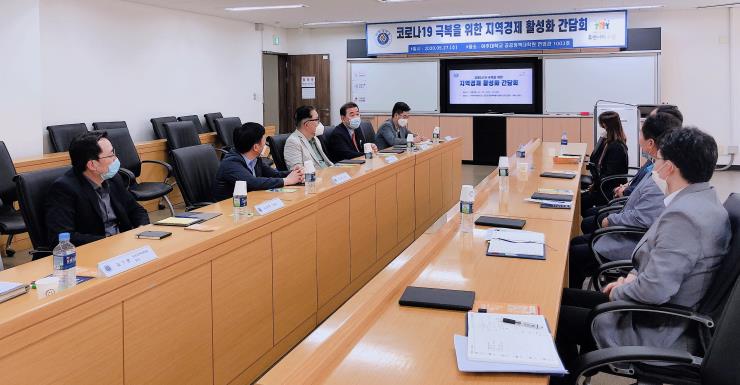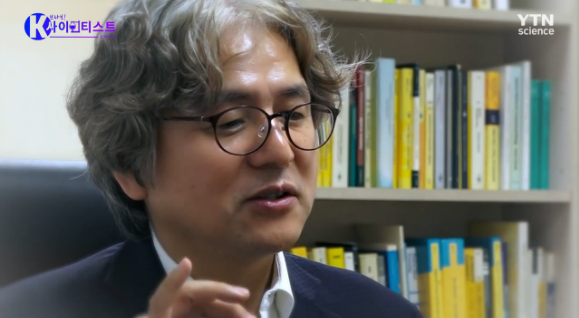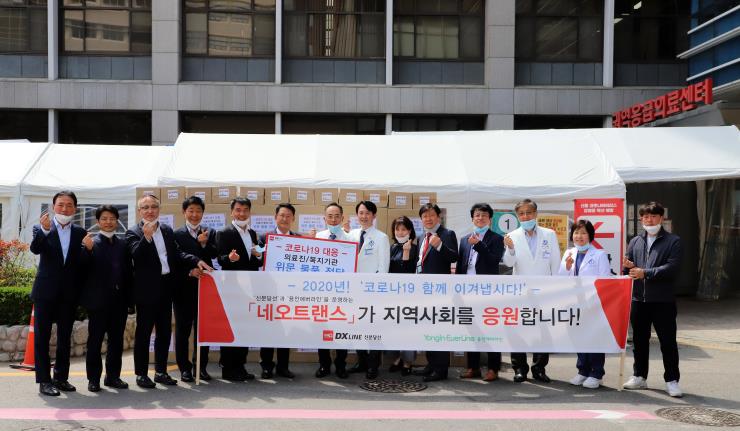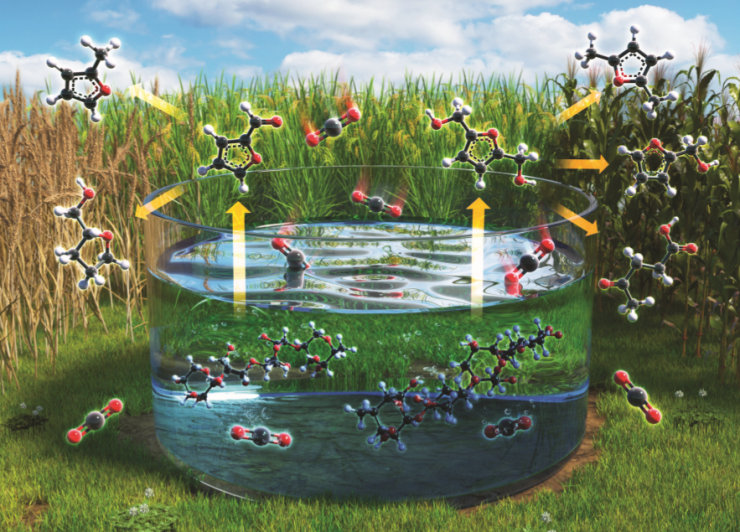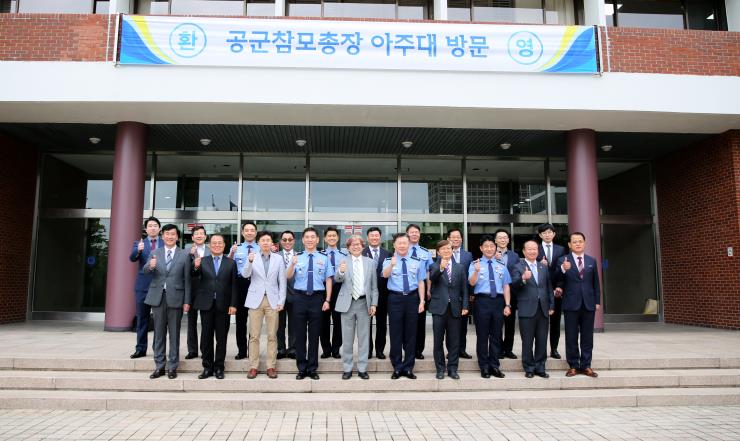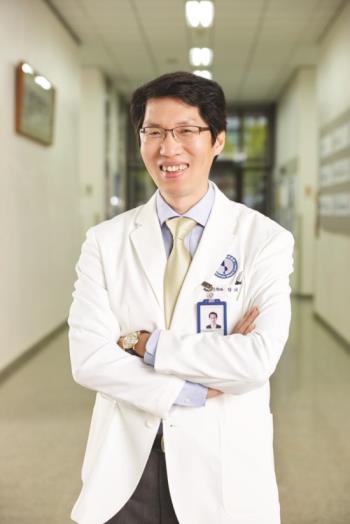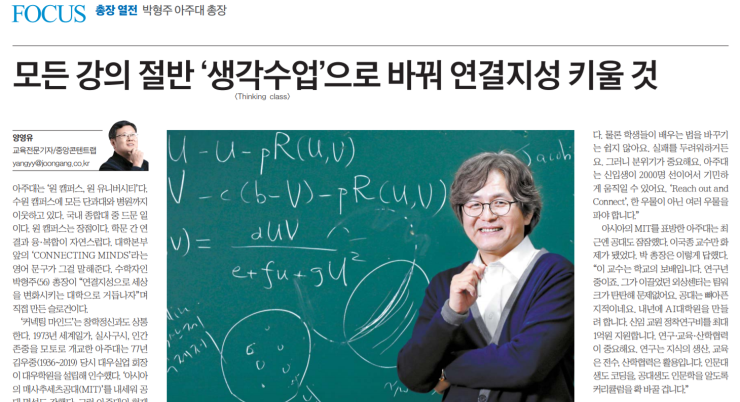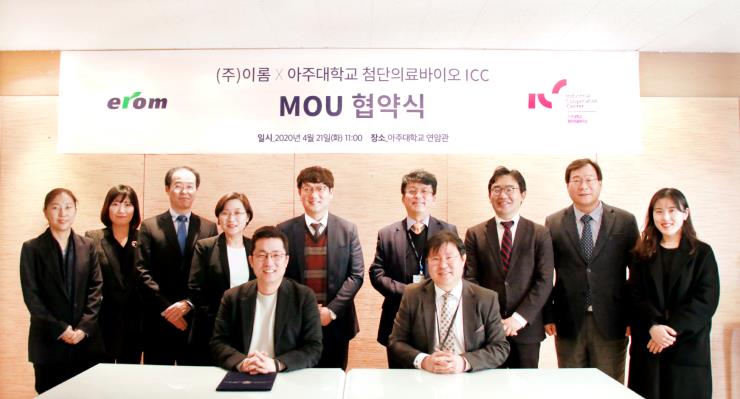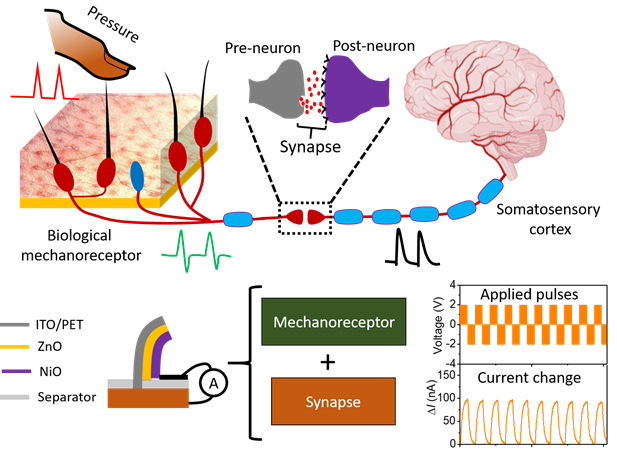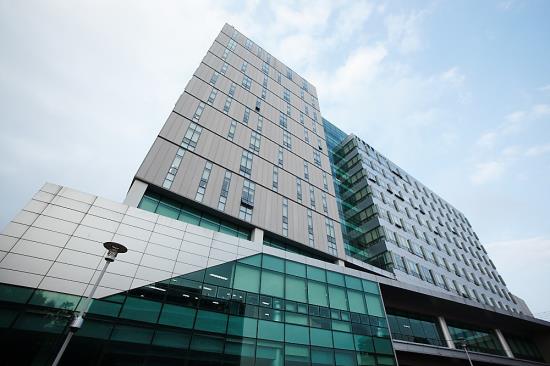-
May 28, 2020 A roundtable discussion was held on boosting the local economy in Suwon, hit hard by the COVID-19 crisis. The discussion took place at Yeonam Hall on campus on May 27, with officials and members from the Yeongtong-gu District Office, Ajou University and Ajou University Hospitals attending. Attending from the district office were Song Yeong-wan, district head; Lee Cheol-su, head of the Economics and Transportation Division; Choi Gwang-bin, Local Economy Team manager; and Chu Hye-gyeong, Planning and Audit Team manager. Present from Ajou University were Kim Heung-sik, Provost, Sim Gyu-cheol, head of the Planning Bureau, and Kim Jong-hyeon, Planning Team manager and from the Graduate School of Public Affairs. Lim Hong-sik, Vice-President of Administration at Ajou University Hospital, was also there. The Yeongtong-gu officials shared a map of popular local restaurants and diners they had recently developed to boost local businesses. The map features restaurants, diners and cafes across seven neighborhoods in the district. All these businesses also accept Suwon Pay, a local currency. The participants exchanged opinions and agreed to work together closely to support the local economy. # View the map of local eateries in your neighborhood.# View the map of local eateries in the Ajou University area.
-
430
- 작성자OI***
- 작성일2020-06-16
- 4848
- 동영상동영상
-
May 26, 2020 The president of Ajou University, Park Hyung-ju, was featured in an episode of YTN Science’s Bravo, K-Scientists! The show focuses on the lives and research achievements of leading scientists in the Korean academic and research community. The episode devoted to Park, entitled “Using Math to Solve Everyday Problems,” was aired at 9 p.m. KST on May 18. Park’s achievements as a mathematician were highlighted in the episode, including his campaign to popularize mathematics and help organize the International Congress of Mathematicians in Seoul in 2014. It also featured Prof. Park’s efforts, since his inauguration as University president in 2018, to reform and innovate higher learning as an educator. Park can be seen emphasizing on the show: “Math education, of course, helps with training scientists and engineers, but it is also an essential component of universal civic education that strives to foster independent thinking. An education in math allows us to learn methods of logical thinking.” The episode also introduced the activities and plans of the Center for Teaching and Learning and the Career Development Center at Ajou University. Park remarked: “It is my job as a decision-maker at the university to find answers in data and prioritize decision-making accordingly. We need to utilize data in order to identify what society and businesses require of us and reflect their demands in our university curriculum.” # Watch YTN Science’s Bravo, K-Scientists!
-
428
- 작성자OI***
- 작성일2020-06-16
- 4674
- 동영상동영상
-
May 20, 2020 A team of researchers led by Ajou’s Prof. Lee Beom-jin (College of Pharmacy) successfully identified a new mechanism for optimizing the efficacy of cancer cell therapies. Their study, entitled “Importance of the fatty acid chain length on in vitro and in vivo anticancer activity of fattigation-platform albumin nanoparticles in human colorectal cancer xenograft mice model,” was published in The Journal of Controlled Release, a prestigious publication for pharmaceutical and pharmacological research. Prof. Lee’s team sought to design fatty acid-conjugated albumin nanoparticles (ANPs) of different chain lengths so as to test and compare their anticancer activities in mice with overactive free-fatty acid receptors (FFARs) and HCT116 human colorectal cancer xenografted. ANPs conjugated with fatty acids of different chain lengths (C4 for butyric acid; C18 for stearic acid) exhibited physicochemical characteristics and anticancer activity different from those of self-assembled structures. In particular, ANPs with long-chain fatty acids including doxorubicin, a known anticancer drug, activated interaction with FFARs in the HCT 116 human colorectal cancer xenograft mouse model, providing better anticancer activity and fewer side effects than either nanoparticles without fatty acids conjugated or ANPs with short-chain fatty acids. Prof. Lee explained: “The uniqueness of our achievement lies in our fattigation platform technology, which conjugates fatty acids of diverse lengths with large molecules. We expect to apply this technology to experiments with fatty acids of varying lengths and accelerate the research on and development of new drug delivery systems, including diverse target cancer therapies and drugs with improved solubility.” An illustration of how Prof. Lee’s team’s technique was applied to improve the efficacy of an anticancer drug in a mouse model
-
426
- 작성자OI***
- 작성일2020-06-16
- 4912
- 동영상동영상
-
May 15, 2020 J&J PharmaTech, a LINC Project group of Ajou University, visited the COVID-19 clinic at Ajou University Hospital to deliver snacks, drinks, and 3,000 personal hand sanitizers to the staff. J&J PharmaTech is a startup run by Jeong Hye-jeong, currently enrolled as a student in the Graduate School of Clinical Pharmacy and Pharmaceutics. The Graduate School revealed that Jeong, along with the school’s dean, Kim Su-dong, and other school officials visited Ajou University Hospital on May 7 to thank the medical staff and deliver donations in person. They were welcomed by the hospital’s president, Dr. Han Sang-uk, and other medical workers on site. Neo Trans, the company operating the Sinbundang Line on the metropolitan transit network across Seoul and Gyeonggi-do, also joined in with delivery of the donations. Jeong explained: “As a LINC Project group of Ajou University’s bio and healthcare industrial cooperation center (ICC), we wanted to do something for the medical staff at the university hospital working on the front line in the current COVID-19 crisis, and thought bringing 3,000 sanitizers was the way to do it.” The ICCs at Ajou University were established with the mission of promoting the University’s research strengths in partnership with local businesses. Faculty members and local firms participate in R&D projects in biotechnology and healthcare, smart mobility, new and renewable energy, artificial intelligence (AI) and big data. Ajou continues to aid local businesses through a wide range of support, including R&D infrastructure, advice, and personnel training.
-
424
- 작성자OI***
- 작성일2020-06-16
- 4301
- 동영상동영상
-
-
422
- 작성자OI***
- 작성일2020-06-16
- 4191
- 동영상동영상
-
May 12, 2020 A delegation of ROK Air Force officers, including the Air Force Chief of Staff, visited Ajou University to discuss matters pertaining to the Department of Military Digital Convergence and terms of cooperation. On May 12, ROK Air Force Chief of Staff, Won In-choul, and other Air Force officers met with a group of faculty members, including University president Park Hyung-ju, in the president’s office at Yulgok Hall. Also present were Prof. Lim Jae-seong, Vice-President of Industrial-Academic Cooperation and Dean of the Department of Military Digital Convergence; Prof. Kim Sang-in, Provost of the College of Information Technology; and Prof. Kim Jeong-sik from the Department of Military Digital Convergence. After exchanging greetings at Yulgok, the officers and the professors then moved to Yeonam Hall to discuss the matters at hand. The Department of Military Digital Convergence came into being in 2015 under a contract between Ajou and the ROK Air Force. All students enrolled in the department are on four-year full scholarships from the Air Force, on the condition that they will serve as commissioned officers for seven years after graduation. Upon completion of all seven years, they may choose to continue their careers in the military or find new opportunities in the defense industry or research. The ROK Air Force Chief of Staff and other high-level officers have been visiting Ajou every year since the department’s creation to meet and encourage the students. This year’s event was downsized from usual in terms of scope and reach due to COVID-19 and the need for social distancing. #What to Study: Department of Military Digital ConvergenceExcerpted from Ajou Insight Spring Edition, 2018
-
420
- 작성자OI***
- 작성일2020-06-16
- 4277
- 동영상동영상
-
May 12, 2020 A team of researchers led by Ajou University’s Prof. Kim Jong-hyun has unraveled the mechanism behind the design of a conjugated polymer. Capable of maximizing conductivity, these polymers are emerging as key next-generation components for electronics. The team included two professors from Ajou - Kim (Dept. of Applied Chemistry and Biological Engineering and Graduate Dept. of Molecular Science and Technology, pictured) and Seo Hyung-tak (Dept. of Materials Science and Engineering and Graduate Dept. of Energy Systems) - as well as Prof. Kim Bong-gi of Konkuk University and Prof. Park Hui-joon of Hanyang University. The team’s study was published as part of the online version of Advanced Functional Materials, dated May 4. Entitled “Unraveling Doping Capability of Conjugated Polymers for Strategic Manipulation of Electric Dipole Layer toward Efficient Charge Collection in Perovskite Solar Cells,” the article also featured Yoon Sang-eun, currently enrolled in the postgraduate program in the Department of Materials Science and Engineering at Ajou, as principal investigator. The conjugated polymers at the heart of the article are organic compounds recently drawing significant attention as the potential next-generation alternative to semiconductors. These conductive organic compounds boast properties superior to those of inorganic ones. Chemical doping, in particular, can enhance the conductivity of these polymers to a par with that of metals, making them even more likely as a candidate material for dipoles in electronic devices. These polymers also have the added benefits of being lightweight, pliable, and not so costly to manufacture. The team’s work is noteworthy for unraveling the exact mechanism behind the design of the conjugated polymers, and particularly why they are so highly conductive. The researchers identified the skeleton of the conjugated polymer capable of exchanging charges at maximum efficiency with the dopant (a substance added to the semiconductor-manufacturing process). They also introduced a substituent able to optimize diffusion of the dopant, creating a highly conductive (200 S/cm) membrane and determining the doping mechanism. The team then added the highly conductive conjugated polymers to the hole transporting layer to develop a high efficiency (20 percent or more) perovskite solar cell. Prof. Kim commented: “Our latest study documents the groundbreaking discovery of a new mechanism that can dramatically improve the conductivity of polymers. Our findings will lead to the development of polymer-based, pliable and stretchable highly conductive dipoles.” The study was possible with support from the Ministry of Education’s University-Centered Research Lab Support Program (for Molecular Science & Technology Research Center).
-
418
- 작성자OI***
- 작성일2020-06-16
- 4115
- 동영상동영상
-
Prof. Park Rae-woong (Dept. of Biomedical Informatics) at Ajou University’s School of Medicine has joined the growing number of research teams worldwide analyzing big data in an attempt to fight COVID-19. To that end, the professor has teamed up with the Bill & Melinda Gates Foundation. With the new flow of funding from the foundation, Prof. Park and his team intend to convert COVID-19 clinical testing data into medical big data to be shared with medical professionals and researchers worldwide. The Bill & Melinda Gates Foundation is a well-known charity fund established and run by Bill Gates, the founder of Microsoft, and his wife, Melinda. Prof. Park will spend the seven months from March 26 to October 1 this year converting the COVID-19 clinical test data from two general hospitals in the Daegu-Gyeongbuk region into a medical big data platform based on the common data model (CDM). The CDM renders patients’ digital medical data anonymous and standardized on a par with the global standard. Using such a model, researchers worldwide can develop analytical programs, also in line with the global standard, and share them with other participating researchers and organizations in return for analyzed statistics. The CDM, in other words, simultaneously ensures the protection of privacy and the multiplication of useful data and resources for researchers. Prof. Park and his team expect to achieve timely conversion of COVID-19 medical data using their platform for comprehensive analysis of big data (“FeederNet”) and thereby enable medical and science communities worldwide to identify the key characteristics and risk factors of the disease, and gain a better understanding of the effects and side effects of the diverse treatments being attempted. “We expect the latest partnership to promote the global community’s understanding of COVID-19, generate real-world evidence on the disease, and foment collaboration among researchers worldwide toward finding solutions,” said Prof. Park. As leader of the Federated E- Health Big Data for Evidence Renovation Network, a major national R&D project funded by Korea’s Ministry of Trade, Industry and Energy, Prof. Park has already been standardizing clinical big data from 63 medical institutions across the country. As a well-known medical big data expert, Prof. Park is also one of the founding members of Observational Health Data Sciences and Informatics (OHDSI), a multi-agency research network that encompasses over 200 research institutes worldwide. OHDSI has helped to convert clinical data on over two billion people worldwide into a CDM. #Prof. Park’s Column: “[Ajou Insights] Medicine and Big Data”
-
416
- 작성자OI***
- 작성일2020-05-15
- 4786
- 동영상동영상
-
An interview with Park Hyung-ju, President of Ajou University, has been published in the April 25 edition of JoongAng Sunday. The interview took place in the president’s office on April 8. President Park was asked a number of questions in the interview concerning the founding philosophy and history of the university, the current status of online learning and future plans, the Blue Semesters, his own philosophy on education, and the impact of COVID-19 on learning. Explaining that “universities are where we learn how to learn,” President Park emphasized that university lectures should evolve into “thinking classes” with “blended learning” programs that cater to student capabilities, majors and different learning conditions in both online and offline environments. “Research, education, and industrial-academic collaboration are crucial,” said Park, as “research produces knowledge, education imparts that knowledge, and industrial-academic collaboration applies that knowledge.” He added: “We will change our curriculum so that those majoring in the humanities will also learn coding and engineering majors will also explore the humanities.” Check out the May issue of Monthly JoongAng to read the interview. #Go to the JoongAng Sunday interview article
-
414
- 작성자OI***
- 작성일2020-05-15
- 4792
- 동영상동영상
-
The bio and healthcare industrial cooperation center (ICC) at Ajou University has recently signed a memorandum of understanding (MOU) with Erom to establish a partnership for the creation and joint management of a new immunology research center. The ICC (led by Prof. Kim Su-dong, College of Pharmacy) announced that it entered the partnership with Erom Company on April 21. The parties have agreed to work closely on joint organization and management of an immunology research center, particularly focusing on analyzing immunity-boosting materials and developing new products. Kim Sang-min, CEO of Erom (Ajou Class of 1992, history) remarked: “This MOU gives us an opportunity to work with Ajou University’s research team on researching, developing, testing and commercializing new immunity-boosting products. I hope this partnership will enable us to bring the benefits of novel products to more people.” The ICC and Erom will particularly work together on basic and clinical research on a rice bran extract (“Erom 4”), which Erom’s researchers have been studying for years for its ability to boost the human immune system. The ICCs are clusters, created by Ajou University, to foster collaboration with local businesses and industries on areas of and discoveries in science in which the university’s researchers specialize. There are four areas of specialization: bio-health care, smart mobility, new and renewable energy, and AI and big data. The university provides the necessary infrastructure, advice, and human resource development tools that local businesses need to support their growth.
-
412
- 작성자OI***
- 작성일2020-05-15
- 4801
- 동영상동영상
-
A team of researchers led by Professor Seo Hyeong-tak of Ajou University has developed an artificial synapse for tactile perception. The new device, which emulates tactile perceptions involving touch and nerves, features a hetero-junction of oxides. Expected applications include skin-attached electronics and artificial intelligence (AI) sensors. Prof. Seo (Dept. of Materials Science and Engineering / Graduate Dept. of Energy Systems, pictured) and his team’s work was published under the title, “An artificial piezotronics synapse for tactile perception,” in an online issue of Nano Energy on April 15, 2020. Also on the team from Ajou University were Prof. Kim Sang-wan (Dept. of Electrical and Computer Engineering) and Dr. Mohit Kumar (researcher, Dept. of Materials Science and Engineering). Of the five senses humans have at their disposal, tactile perception involves the signals stimulated by a touch traveling from the stimulus receptor at the terminal of the skin to cranial nerves via the neural network. Humans are able to discern an incredibly wide range of touches on their skin. Combined with emotions of varying depths, these tactile perceptions can become part of human memory. An artificial synapse that emulates the human tactile perception therefore epitomizes a highly sophisticated technology capable of detecting the wide variety of touches exerted from the outside world with finesse and precision, saving perceptions thereof, and retrieving them in a memory-like fashion. Prof. Seo’s team achieved such an advanced artificial synapse, featuring a hetero-junction of nickel and zinc oxides (NiO and ZnO) that emulates tactile stimulation of nerves. Specifically, the synapse was designed to emulate how hair detects changes in external pressure using a vertically structured sensor featuring the hetero-junction of oxides. It is this sensor that produces changes in the current-voltage curve in response to changing intensity and directions of pressure in a fashion similar to how the human body perceives touch. Concept of a very transparent and flexible artificial synapse that emulates environment-adaptable tactile perceptions The team’s discovery is all the more significant due to its ability to remember tactile changes in electric currents, in the form of conserved charges, for a certain period of time, in a fashion similar to non-volatile memory. The artificial synapse is capable of emulating all the typical functions of actual neuron synapses, such as perceiving changes in signals, whether in intensity or over time and in size. The invention therefore bears much functional similarity to an actual in-vivo tactile neural circuit. Prof. Seo explained: “We created a test touch pad with multiple artificial synapses arranged on it, and discovered that the pad is capable of effectively detecting temporal-spatial information from external variables, such as the amplitude and duration of stimuli. We also demonstrated that the synapse is capable of discerning different pressure patterns.” The artificial neural circuit architecture that simulates sensory nerve functions from touch to the brain requires the integration of a pressure sensor, a connecting cable, and an artificial synapse. This is an extremely sophisticated technology that involves quite complex machinery and ultra-low energy consumption. Prof. Seo’s team has created an ultra-energy-light and high-precision artificial synapse, using a relatively simple manufacturing process, that can adjust output in response to variations in tactile input. Prof. Seo further commented: “The artificial synapse we developed this time is comparatively less complex and consumes less energy than other preexisting and similar tactile circuits. At the same time, it provides superior environment-adaptable detections of touch. We anticipate that our invention can be made into various applications, including AI sensors, skin-attachable electronics, robotics, and prosthetic limbs for people with disabilities.” The study was conducted with support from the New Future Device and Original Technology Development Program and the Basic Research Support Program for Established and New Projects , sponsored by the Ministry of Science and ICT and the National Research Foundation of Korea, respectively.
-
410
- 작성자OI***
- 작성일2020-05-15
- 4885
- 동영상동영상
-
-
408
- 작성자OI***
- 작성일2020-05-15
- 4543
- 동영상동영상

